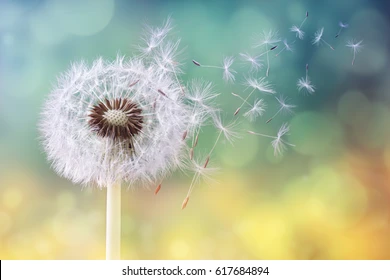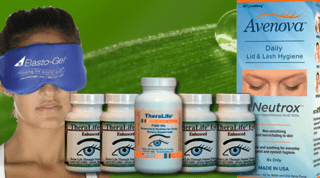Seasonal Allergies and Dry Eyes
Around the world, millions of people struggle with seasonal allergies. Allergic reactions to springtime pollens, summer dust, and late-blooming plants in the fall can contribute to numerous symptoms, leaving allergy sufferers miserable.
Unfortunately, many of the medical treatments for allergy relief also have their share of side effects, notably dry eyes. In this guide, we’ll explore the link between allergies and dry eyes, including medications that can aggravate dry-feeling eyes. Then, we’ll provide tips for keeping your eyes moist and irritation-free.
Seasonal Allergies or Dry Eyes?
Many people associate the onset of allergy season with the sensation of dry, gritty, and irritated eyes. Not all allergy sufferers will experience dry eyes, but it is a common symptom. Chronic dry eye syndrome, more commonly known as Dry Eye Disease – a condition that affects people with or without allergies — can sometimes create confusion from a diagnostic perspective.
Is a person experiencing dry eyes, a reaction to a seasonal allergen, or both?
Patients with Dry Eye Disease develop the condition due to two primary causes:
- Insufficient tear production
- Dysfunction of the Meibomian glands, which produce the oily substance that keeps the eye surfaces moist and lubricated.
How Can You Tell?
To differentiate whether a person has chronic dry eyes or is struggling with a symptom of seasonal allergies, there is one diagnostic sign that can help pinpoint what is going on. That sign is itchiness; allergen sensitivities release a substance called histamine, which can cause redness, itchiness, and excessive tear production.
Absent itchiness, a person is probably experiencing Chronic Dry Eye Syndrome or a related dry eye condition.
Pros and Cons of Anti-Histamines in Treating Dry Eyes
For decades, allergy sufferers have turned to antihistamine products to relieve the symptoms of their allergies. Either over-the-counter or by prescription, antihistamines work to suppress the activity of histamines released as a response to an allergen, such as pollen or dust.
For many people with seasonal allergies and the dry eyes that can be a common symptom, antihistamines may actually aggravate the feeling of dry eyes. In fact, most antihistamine medications cause more dryness, which only serves to further irritate eyes.
There are other unpleasant side effects, notably drowsiness, leading many allergy sufferers to avoid their use.
Natural Solutions for Treating Dry Eyes Associated with Seasonal Allergies
If antihistamine medications can lead to even dryer eyes, what can allergy sufferers do to alleviate the discomfort? Natural alternatives exist, and these can conquer the feeling of dry eyes without contributing to more irritation.
An example is to use an oral dry eye treatment that also treats allergies. These oral formulas can provide long-lasting relief, eliminating the mess and difficulty associated with traditional eye drops.
Millions of people struggle with seasonal allergies and dry eyes. Natural alternatives to prescription medications represent a new way of conquering dry eyes, offering incredible relief without unpleasant side effects.
TheraLife Eye capsules contain ingredients for both dry eyes and allergies. One solution, 2 treatments. All natural without side effects. Get help today from TheraLife.
Continue reading: Why Your Eyes Are Watery: Is It Something in the Air?
References
- National Institutes of Health – https://www.nccih.nih.gov/health/seasonal-allergies-at-a-glance
- National Institutes of Health: https://www.ncbi.nlm.nih.gov/pmc/articles/PMC5895478/
- Review of Opthalmology: https://www.reviewofophthalmology.com/article/dry-eye-or-allergy-how-to-make-the-call[1] American College of Allergy, Asthma, and Immunology. (2018). Allergy Facts. http://acaai.org/news/facts-statistics/allergies[2] Centers for Disease Control and Prevention. (2019). 2018 National Health Interview Survey data. U.S. Department of Health and Human Services. Retrieved from https://www.cdc.gov/nchs/fastats/allergies.htm
[3] FoodSafety.gov. (2020). Protect Yourself from Food Allergies. U.S. Department of Health and Human Services. https://www.foodsafety.gov/blog/protect-yourself-food-allergies
[4] Wood, R. A., Camargo, C. A., Lieberman, P., Sampson, H. A., Schwartz, L. B., Zitt, M., Collins, C., Tringale, M., Wilkinson, M., Boyle, J., & Simons, F. E. R. (2014). Anaphylaxis in America: the prevalence and characteristics of anaphylaxis in the United States. The Journal of Allergy and Clinical Immunology, 133(2), 461–467. https://doi.org/10.1016/j.jaci.2013.08.016[5] Jerschow, E., Lin, R. Y., Scaperotti, M. M., & McGinn, A. P. (2014). Fatal anaphylaxis in the United States 1999-2010: temporal patterns and demographic associations. The Journal of Allergy and Clinical Immunology, 134(6), 1318-1328.e7. https://doi.org/10.1016/j.jaci.2014.08.018[6] Gupta, R., Holdford, D., Bilaver, L., Dyer, A., Holl, J. L., & Meltzer, D. (2013). The Economic Impact of Childhood Food Allergy in the United States. JAMA Pediatrics, 167(11), 1026. https://doi.org/10.1001/jamapediatrics.2013.2376[7] Gupta, R. S., Warren, C. M., Smith, B. M., Jiang, J., Blumenstock, J. A., Davis, M. M., Schleimer, R. P., & Nadeau, K. C. (2019). Prevalence and Severity of Food Allergies Among US Adults. JAMA Network Open, 2(1), e185630. https://doi.org/10.1001/jamanetworkopen.2018.5630 [8] Gupta, R. S., Warren, C. M., Smith, B. M., Blumenstock, J. A., Jiang, J., Davis, M. M., & Nadeau, K. C. (2018). The Public Health Impact of Parent-Reported Childhood Food Allergies in the United States. Pediatrics, 142(6). https://doi.org/10.1542/peds.2018-1235[9] Turnbull, J. L., Adams, H. N., & Gorard, D. A. (2014). Review article: the diagnosis and management of food allergy and food intolerances. Alimentary Pharmacology & Therapeutics, 41(1), 3–25. https://doi.org/10.1111/apt.12984[10] American Academy of Allergy, Asthma, and Immunology. (2013). Allergy Statistics.. https://www.aaaai.org/about-aaaai/newsroom/allergy-statistics[11] American Academy of Allergy, Asthma, and Immunology. (2019). Penicillin Allergy FAQ. https://www.aaaai.org/conditions-and-treatments/library/allergy-library/penicillin-allergy-faq[12] Wu, M., McIntosh, J., & Liu, J. (2016). Current prevalence rate of latex allergy: Why it remains a problem? Journal of Occupational Health, 58(2), 138–144. https://www.ncbi.nlm.nih.gov/pmc/articles/PMC5356959/[13] Ludman, S. W., & Boyle, R. J. (2015). Stinging insect allergy: current perspectives on venom immunotherapy. Journal of Asthma and Allergy, 8, 75–86. https://doi.org/10.2147/JAA.S62288[14] American College of Allergy, Asthma, and Immunology. (2018). Insect Sting Allergies | Symptoms & Treatment. ACAAI Public Website. https://acaai.org/allergies/types/insect-sting-allergy





